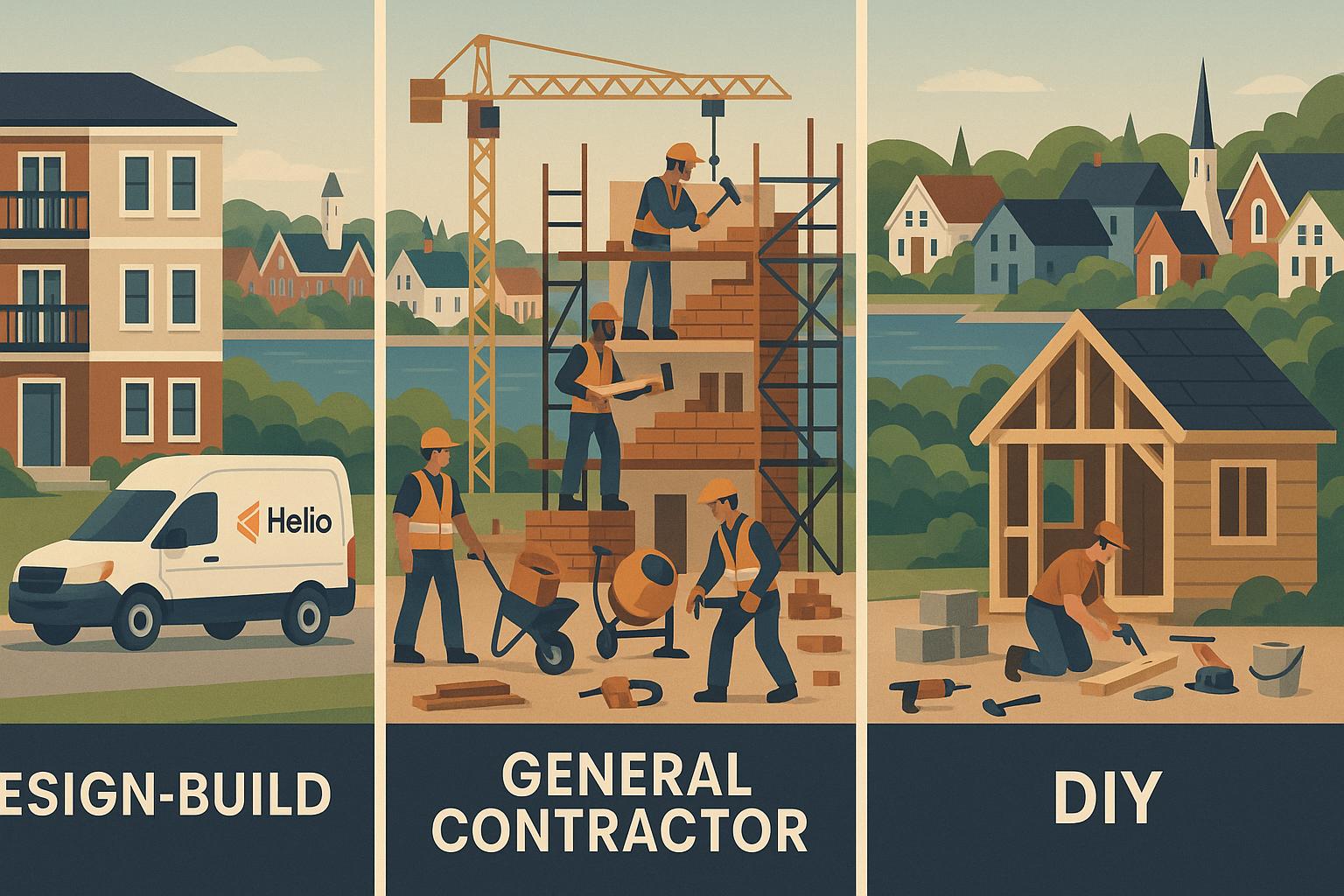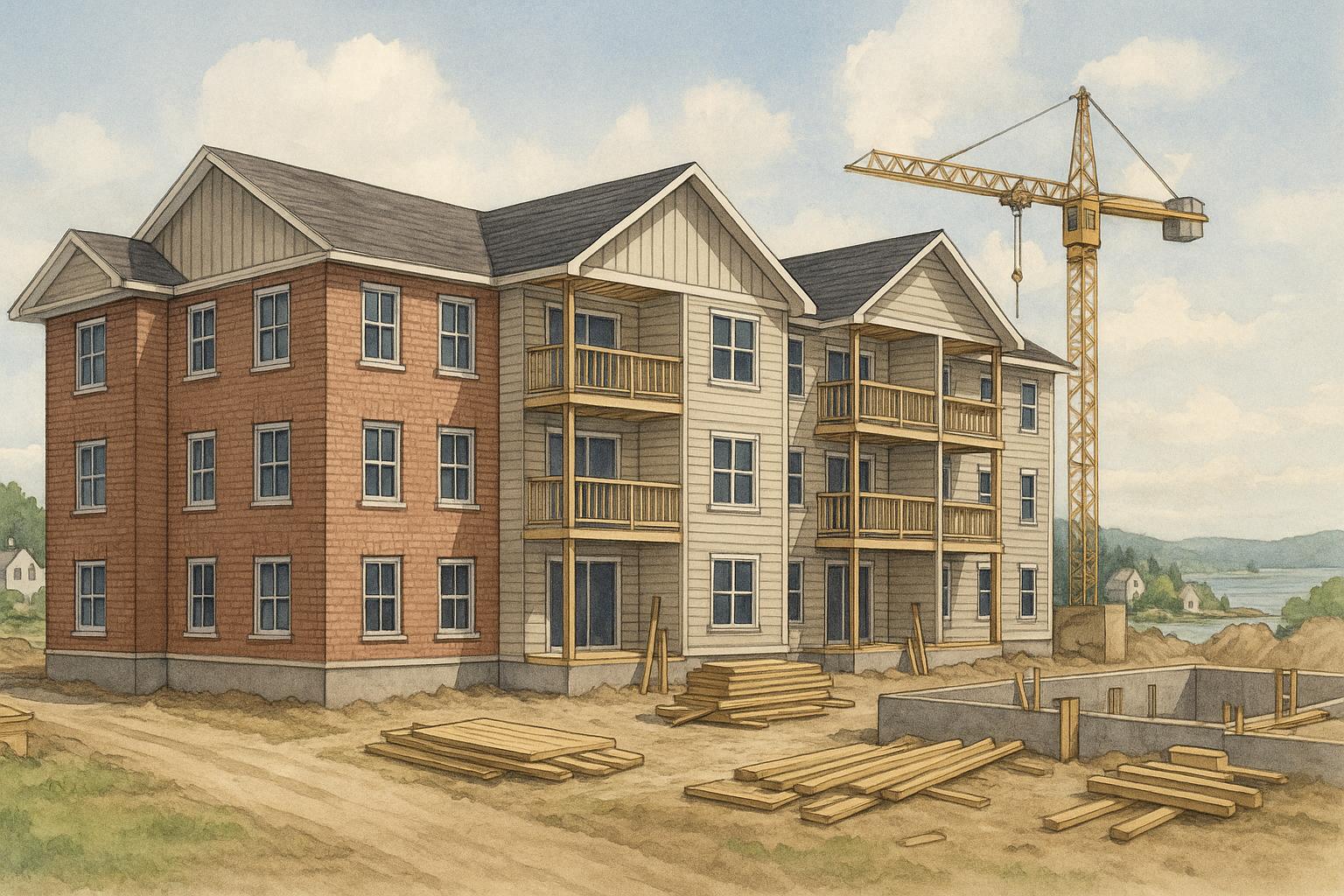Nova Scotia winters are tough, but preparing your property can save you money and prevent costly repairs. Here's what you need to know:
- Insulation is key: Use high R-value materials like spray foam or rigid foam boards to cut heating costs and reduce moisture issues.
- Triple-pane windows: These retain heat better than double-pane options, lowering heating bills and reducing noise.
- Snow-ready roofing: Metal roofs and engineered trusses handle snow loads better and last longer.
- Air sealing: Caulking, weatherstripping, and sealing gaps prevent heat loss and drafts.
- Energy-efficient systems: Heat pumps, HRVs, and smart thermostats improve heating efficiency and tenant comfort.
- Regular maintenance: Protect pipes, service heating systems, and stock emergency supplies to handle storms and outages.
Investing in proper materials and upkeep not only keeps tenants comfortable but also increases your property’s value and reduces long-term expenses.
How to Winter-Proof Your House and Save Money!
Winter-Resistant Construction Materials for Nova Scotia Climate
Choosing the right materials for construction in Nova Scotia is critical to managing heating costs, ensuring tenant comfort, and avoiding expensive repairs. Below are some materials that combine durability with energy efficiency.
Triple-Pane Windows
Triple-pane windows with low-E coatings are a smart choice for Nova Scotia's cold winters. These windows feature three layers of glass filled with insulating gas, which helps retain heat and block out the cold. The low-E coating reflects indoor heat back into the room, boosting energy efficiency. For perspective, while double-pane windows have an R-value of about 3, triple-pane windows can exceed 7, leading to noticeable savings on heating bills. Beyond energy efficiency, the extra glass layer and gas filling reduce outside noise and minimize condensation, which lowers the risk of mould growth.
High R-Value Insulation
Insulation plays a huge role in both energy savings and comfort. While Nova Scotia's building code outlines minimum R-values, going beyond these standards can further cut heating costs and enhance indoor comfort. Spray foam insulation is a popular option, offering an R-value of 6–7 per inch and sealing gaps effectively. On the other hand, fibreglass batts provide about 3.5 R-value per inch, making them a more affordable but less efficient alternative.
Rigid foam board is another excellent choice, particularly for exterior walls and basements. It provides continuous insulation that reduces thermal bridging - heat loss through structural elements like studs and joists. This not only prevents cold spots but also reduces the risk of condensation and mould. Additionally, properties with high-quality insulation may qualify for incentive programs like CMHC MLI Select, which offer more favourable financing terms and improve cash flow.
Snow-Load-Resistant Roofing
Nova Scotia’s winters demand roofs that can handle heavy snow and ice. Metal roofing is particularly effective, as snow slides off more easily compared to asphalt shingles, reducing the weight on the structure and the risk of ice dams. Plus, metal roofs typically last 40–50 years, far outlasting asphalt shingles, which last around 15–20 years.
Engineered roof trusses are another must-have for local conditions. These are designed to support the weight of heavy snow while allowing enough space for proper attic insulation, improving overall energy efficiency. To further protect against ice dams, installing an ice and water shield along roof edges is a good idea. This waterproof membrane should extend at least 60 cm from the roof edge to safeguard vulnerable areas from water infiltration.
Weather-Resistant Exterior Cladding
Exterior cladding must endure Nova Scotia's freeze-thaw cycles while providing good protection against moisture. Fibre cement siding is a strong contender, as it resists rot and performs well under these conditions. It also offers better fire resistance compared to wood or vinyl.
Engineered wood is another option, offering better moisture resistance than traditional wood while maintaining its aesthetic appeal. Vinyl siding remains a popular choice due to its low cost and minimal maintenance. Some vinyl systems even include insulated backing for improved thermal performance. However, lower-grade vinyl can become brittle in extreme cold, so it’s important to choose high-quality materials.
No matter the cladding type, proper installation is essential for long-term performance. This includes using house wraps, flashing, and ventilation to manage moisture effectively and ensure durability over time.
Insulation and Air Sealing Techniques
When it comes to preparing buildings for Nova Scotia's harsh winters, combining proper insulation with effective air sealing is a must. Even the best insulation won’t perform well if air leaks allow heat to escape. By addressing both, you can improve energy efficiency and keep tenants comfortable throughout the colder months.
Air Sealing Methods
Air sealing focuses on closing off the small cracks and gaps that let warm, conditioned air escape. These seemingly minor openings can lead to significant heat loss, especially in multi-unit buildings, making air sealing a smart and cost-effective solution.
- Caulking: Use polyurethane caulk around frames, as it remains flexible during freeze-thaw cycles. For areas that experience movement, such as where siding meets the foundation, paintable acrylic latex caulk is a better choice since it can expand and contract without cracking.
- Weatherstripping: Choose the right type of weatherstripping for the job. V-strip weatherstripping works well for certain window types, while door sweeps and threshold seals are ideal for stopping drafts at the bottom of exterior doors. Be sure to replace weatherstripping periodically, as temperature changes can wear it down.
- House Wraps and Moisture Barriers: House wraps are excellent for controlling air and moisture infiltration. In basements, applying plastic sheeting over concrete walls before adding insulation can help prevent moisture issues, such as mould growth.
- Sealing Penetrations: Use expanding foam to seal gaps around exterior wall penetrations, like those for plumbing or electrical lines. Be careful not to overapply. Adding foam gaskets behind outlet covers on exterior walls can also block unwanted air leaks.
By combining these sealing methods, you create a solid foundation for your insulation strategy, ensuring maximum energy efficiency.
Insulation for Attics, Walls, and Basements
Each part of a building requires its own tailored insulation approach to handle Nova Scotia's winter conditions effectively. A well-thought-out plan can reduce energy consumption and address common cold-weather problems.
- Attics: Blown-in insulation is a great option for filling gaps in the attic. Pair it with proper attic ventilation to prevent ice dams and moisture buildup, as heat naturally rises and collects in this area.
- Walls: For existing buildings, dense-pack cellulose insulation can be blown into wall cavities. This not only improves thermal performance but also helps with air sealing, all without requiring major renovations. For new builds or extensive remodels, consider optimizing wall framing to allow for higher insulation levels.
- Basements: Insulating basement walls is key to reducing heat loss and improving comfort in lower-level units. Rigid foam boards applied directly to concrete walls work well as both insulation and vapour barriers. Don’t forget the rim joists - using spray foam or rigid foam here can address air infiltration and further improve energy savings.
Energy-Efficient Heating and Ventilation
Once your building is well-sealed and insulated, modern heating and ventilation systems can take your property's energy efficiency to the next level. The goal is to deliver heat efficiently while maintaining good air quality.
- Heat Recovery Ventilators (HRVs): These systems bring in fresh air without losing too much heat. HRVs capture heat from outgoing air and use it to pre-warm incoming air, making them an excellent choice for tightly sealed buildings. Proper sizing based on the building's volume and occupancy is critical for optimal performance.
- Ductless Mini-Split Heat Pumps: Popular in Nova Scotia, these systems are efficient even in very cold conditions. They provide both heating and cooling, with the added bonus of individual zone control. Multi-zone systems can serve multiple units from a single outdoor unit, reducing installation costs while still allowing tenants to control their own temperatures. To prevent snow interference, outdoor units should be installed on elevated platforms or wall brackets.
- Programmable and Smart Thermostats: These devices can adjust temperatures automatically based on occupancy patterns. Smart thermostats, in particular, can learn user habits and offer remote control options, which is especially useful for rental properties where tenants might forget to adjust settings.
Lastly, don’t overlook ductwork in forced-air systems. Sealing joints with appropriate materials and insulating ducts that pass through unheated spaces can prevent heat loss and significantly improve overall system efficiency.
sbb-itb-16b8a48
Winter Upkeep and Preventive Maintenance for Multi-Unit Properties
Taking care of your property during Nova Scotia's harsh winter storms goes beyond keeping tenants comfortable - it’s about protecting your investment and ensuring everyone’s safety. When severe weather hits, having a solid emergency preparedness plan can help minimize disruptions and safeguard both residents and the building itself. Here’s a practical guide to winter upkeep that complements earlier design strategies.
Emergency Preparedness
Proactive winter maintenance works hand-in-hand with resilient construction and proper insulation. Start by creating a detailed plan to handle power outages, heating failures, and severe storms. Make sure all tenants are familiar with the plan, including evacuation routes and the locations of nearby emergency shelters if evacuation becomes necessary [1][3].
Keep a list of essential contacts, such as emergency services, utility providers, and 24-hour contractors. Store critical documents - like tenant records, insurance policies, and emergency protocols - in a secure, remote backup system to ensure access even during power outages [1].
Stock up on essential supplies to maintain operations and safety during severe weather. This includes:
- Battery-powered radios, flashlights, and extra batteries
- Generators and enough fuel for at least 72 hours
- Fully stocked first aid kits
- Sandbags, extra clothing, blankets, non-perishable food, and bottled water [1][2][4]
Beyond supplies, take steps to protect your property’s key systems. Regularly service mechanical rooms and heating systems to prevent frozen pipes. Insulate any exposed pipes and completely drain irrigation systems to avoid freezing damage [1][4].
Prepare for power outages by familiarizing yourself with how to manually open gates and disconnect power to gate systems. Test backup generators monthly to ensure they’re operational and keep fuel reserves topped up [1].
Finally, establish clear communication channels to keep tenants informed during emergencies. Use phone trees, email lists, or notices posted in common areas to share updates quickly. Clear communication reduces confusion and ensures everyone knows what steps to take when severe weather strikes.
Integrated Construction Approach: Simplifying Winter-Proofing
Traditional winter-proofing often involves juggling multiple professionals, each with their own schedules, budgets, and areas of responsibility. This fragmented process can make it harder to ensure all elements work together effectively. Enter the integrated design-build approach: a solution that brings design, engineering, and construction under one roof. This streamlined method not only simplifies project management but also offers several key benefits.
Benefits of Single Accountability
Issues like poor insulation or inadequate air sealing can lead to expensive fixes that no one takes responsibility for. With an integrated builder, everything is handled under a single contract. This ensures clear accountability, fixed pricing, and on-time delivery, often within shorter timelines. Unlike traditional cost-plus projects, where overruns are common, this approach locks in costs and minimizes surprises.
Some integrated builders even include financial penalties - up to $1,000 per day - for delays, providing extra assurance that deadlines will be met. This level of coordination ensures that every winter-proofing feature, from triple-pane windows to snow-load-resistant roofing, is designed and installed to function seamlessly together. By aligning insulation, air sealing, and roofing systems, the integrated approach meets winter-proofing standards with precision.
Accessing Rebates and Incentives
Navigating government rebate programs can be daunting, but integrated builders often simplify the process by managing the required paperwork and ensuring compliance with program guidelines. Many winter-proofing incentives, such as those offered by Efficiency Nova Scotia and the Canada Greener Homes Initiative, require licensed professionals and specific documentation - tasks that integrated teams handle as part of their workflow.
For example, the Canada Greener Homes Initiative provides grants ranging from $125 to $5,000 for eligible retrofits, with a maximum of $5,600 per household when evaluation costs are included. Multi-unit residential buildings can also access tailored grants, and the program offers interest-free loans of up to $40,000 with a 10-year repayment term for major upgrades [5][7].
Integrated builders ensure compliance with these programs by managing details like contractor attestation forms for heat pump installations or ensuring ENERGY STAR labels remain intact on windows and doors until post-retrofit evaluations are complete [5]. This attention to detail helps maximize financial benefits while ensuring proper installation.
Additionally, programs like HomeWarming provide no-cost upgrades for lower-income homeowners, including draft-proofing and insulation. Eligible participants may also receive up to $15,000 to switch from oil heating to electric heat pumps [6][8]. By coordinating these upgrades with other construction tasks, integrated builders not only increase the value of rebates but also enhance the overall effectiveness of winter-proofing efforts. Their expertise in documentation and single-source accountability makes the entire process smoother and more efficient.
Conclusion: Long-Term Value of Winter-Proofing
Winter-proofing your multi-unit property in Nova Scotia offers rewards that far outweigh the upfront investment. By incorporating energy-efficient features, you not only lower utility expenses but also make your property more appealing to dependable tenants. This gives your property a strong position in Nova Scotia's competitive rental market.
Beyond the financial perks, winter-proofing adds to the overall durability of your building. Proper air sealing keeps moisture at bay, protecting against structural issues, while high-quality insulation reduces thermal stress on building materials. These measures help you avoid costly repairs during the harsh Maritime winters, preserving the value of your investment.
The financial benefits are just as compelling. Properties with proper insulation and efficient heating systems can command rents ranging from $1,950 to $2,100 per month, translating to annual returns of 12–20% for property owners. To achieve these results, it's crucial to adopt a well-coordinated construction strategy where every element works seamlessly together. This approach ensures both durability and profitability for the long term.
FAQs
What are the best affordable insulation options to improve energy efficiency in a Nova Scotia home?
Fibreglass insulation is a popular and affordable way to boost energy efficiency in homes across Nova Scotia. Known for its dependable thermal performance, it’s easy to find and fits well within the budget of many homeowners. If you're looking for a practical solution to keep energy costs down, this option is worth considering.
Another alternative is cellulose insulation, crafted from recycled materials. It’s not only effective in improving energy efficiency but also a more environmentally friendly choice. Both fibreglass and cellulose insulation can help cut heating expenses during Nova Scotia's chilly winters, ensuring your home stays warm and comfortable for everyone inside.
How can I make my property's heating system more efficient and cost-effective for Nova Scotia's winters?
To keep your heating system running efficiently and save on costs during Nova Scotia's harsh winters, try these practical strategies:
- Upgrade insulation and seal drafts: Ensuring your home is well-insulated and free of drafts can drastically cut down on heat loss, which means lower energy bills and a warmer home.
- Install a heat pump: Heat pumps are an energy-efficient alternative, delivering two to three times more heat per unit of energy compared to traditional heating systems. Plus, you might be eligible for rebates when installing one.
- Look into energy-saving programs: Initiatives like the HomeWarming program offer free energy efficiency upgrades for homeowners who meet income requirements. Additionally, the Oil to Heat Pump Affordability Grant provides rebates of up to $15,000 to help with the transition to electric heat pumps.
- Book an energy assessment: A professional energy assessment can pinpoint areas of inefficiency and suggest targeted improvements. If you're a moderate-income household, you might even qualify for a free assessment.
By following these steps, you can make your heating system more effective, lower your energy bills, and create a more comfortable living environment for tenants.
How does an integrated construction approach make winter-proofing my Nova Scotia property easier and more effective?
An integrated construction approach streamlines the process of preparing your property for winter by ensuring smooth coordination through every step of the project. Unlike traditional methods that often involve juggling multiple contracts - leading to potential delays or miscommunication - this method offers single accountability. One dedicated team oversees the entire project, cutting down on confusion and delivering more reliable outcomes.
This process takes the uncertainty out of construction by following a clear, step-by-step plan. It ensures your property is equipped with winter-resistant materials and features like energy-efficient windows and roofs built to withstand heavy snow loads. These elements are specifically designed to endure Nova Scotia's tough winter conditions. The result? A hassle-free experience, minimal unexpected issues, and a property that's ready to keep tenants comfortable while safeguarding your investment.



